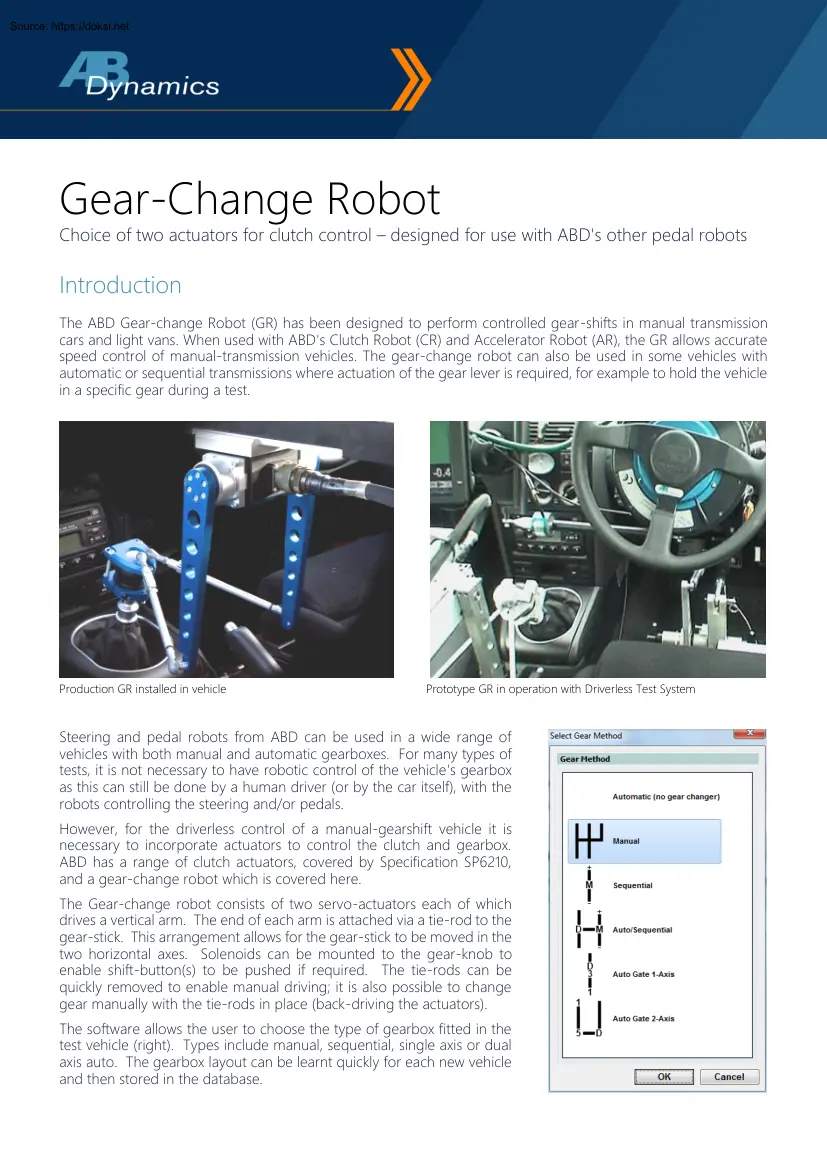Comments
No comments yet. You can be the first!
What did others read after this?
Content extract
Gear-Change Robot Choice of two actuators for clutch control – designed for use with ABD's other pedal robots Introduction The ABD Gear-change Robot (GR) has been designed to perform controlled gear-shifts in manual transmission cars and light vans. When used with ABD's Clutch Robot (CR) and Accelerator Robot (AR), the GR allows accurate speed control of manual-transmission vehicles. The gear-change robot can also be used in some vehicles with automatic or sequential transmissions where actuation of the gear lever is required, for example to hold the vehicle in a specific gear during a test. Production GR installed in vehicle Prototype GR in operation with Driverless Test System Steering and pedal robots from ABD can be used in a wide range of vehicles with both manual and automatic gearboxes. For many types of tests, it is not necessary to have robotic control of the vehicle's gearbox as this can still be done by a human driver (or by the car itself), with the
robots controlling the steering and/or pedals. However, for the driverless control of a manual-gearshift vehicle it is necessary to incorporate actuators to control the clutch and gearbox. ABD has a range of clutch actuators, covered by Specification SP6210, and a gear-change robot which is covered here. The Gear-change robot consists of two servo-actuators each of which drives a vertical arm. The end of each arm is attached via a tie-rod to the gear-stick. This arrangement allows for the gear-stick to be moved in the two horizontal axes. Solenoids can be mounted to the gear-knob to enable shift-button(s) to be pushed if required. The tie-rods can be quickly removed to enable manual driving; it is also possible to change gear manually with the tie-rods in place (back-driving the actuators). The software allows the user to choose the type of gearbox fitted in the test vehicle (right). Types include manual, sequential, single axis or dual axis auto. The gearbox layout can be learnt
quickly for each new vehicle and then stored in the database. Driverless Testing of Manual Transmission Vehicles The GR, CR and AR may be used with ABD's steering and brake robots to provide a fully driverless testing system for manual transmission vehicles. In this instance, all robots are controlled by an ABD Omni(6) six-channel controller and an additional back-up safety system is employed to provide a fail-safe means of stopping the vehicle. (See ABD specification SP6205 for more details). The gear robot can be used to automatically choose the appropriate gear for a varying speed profile (simulated auto-box mode) and can also be used to select a specific gear for a test. Operation The GR is designed to be easily mounted within a wide range of vehicles without obscuring the driver's vision or access to controls. The GR is set up through a simple 'learn' process whereby the locations of the gears are defined and recorded for a given vehicle. Once the gearbox
layout has been learnt, selection of the gears is then possible within the standard ABD Robot Controller software. For speed control, a series of GR, CR and AR parameters are varied to define the gear changing characteristics of the vehicle. Example test – constant acceleration with gear-changes Typical performance Maximum fore-aft force 200N Maximum lateral force 100N Maximum fore-after stroke ±150mm * Maximum lateral stroke ±100mm * Nominal fore-aft force @ speed 90N @ 1000mm/s Gear-change time Typically ≤0.25 seconds Maximum fore-aft force 200N *Note: Stroke is typically limited by spherical joint angle. Larger linear strokes may be accommodated on vehicles where the angular movement of the gear lever is less. AB Dynamics Middleton Drive Bradford on Avon Wiltshire BA15 1GB England Email: info@abdynamics.com Tel: +44(0)1225 860 200 Release Date 05 June 2019 Document No. SP6211 Issue No. 07
robots controlling the steering and/or pedals. However, for the driverless control of a manual-gearshift vehicle it is necessary to incorporate actuators to control the clutch and gearbox. ABD has a range of clutch actuators, covered by Specification SP6210, and a gear-change robot which is covered here. The Gear-change robot consists of two servo-actuators each of which drives a vertical arm. The end of each arm is attached via a tie-rod to the gear-stick. This arrangement allows for the gear-stick to be moved in the two horizontal axes. Solenoids can be mounted to the gear-knob to enable shift-button(s) to be pushed if required. The tie-rods can be quickly removed to enable manual driving; it is also possible to change gear manually with the tie-rods in place (back-driving the actuators). The software allows the user to choose the type of gearbox fitted in the test vehicle (right). Types include manual, sequential, single axis or dual axis auto. The gearbox layout can be learnt
quickly for each new vehicle and then stored in the database. Driverless Testing of Manual Transmission Vehicles The GR, CR and AR may be used with ABD's steering and brake robots to provide a fully driverless testing system for manual transmission vehicles. In this instance, all robots are controlled by an ABD Omni(6) six-channel controller and an additional back-up safety system is employed to provide a fail-safe means of stopping the vehicle. (See ABD specification SP6205 for more details). The gear robot can be used to automatically choose the appropriate gear for a varying speed profile (simulated auto-box mode) and can also be used to select a specific gear for a test. Operation The GR is designed to be easily mounted within a wide range of vehicles without obscuring the driver's vision or access to controls. The GR is set up through a simple 'learn' process whereby the locations of the gears are defined and recorded for a given vehicle. Once the gearbox
layout has been learnt, selection of the gears is then possible within the standard ABD Robot Controller software. For speed control, a series of GR, CR and AR parameters are varied to define the gear changing characteristics of the vehicle. Example test – constant acceleration with gear-changes Typical performance Maximum fore-aft force 200N Maximum lateral force 100N Maximum fore-after stroke ±150mm * Maximum lateral stroke ±100mm * Nominal fore-aft force @ speed 90N @ 1000mm/s Gear-change time Typically ≤0.25 seconds Maximum fore-aft force 200N *Note: Stroke is typically limited by spherical joint angle. Larger linear strokes may be accommodated on vehicles where the angular movement of the gear lever is less. AB Dynamics Middleton Drive Bradford on Avon Wiltshire BA15 1GB England Email: info@abdynamics.com Tel: +44(0)1225 860 200 Release Date 05 June 2019 Document No. SP6211 Issue No. 07





 Just like you draw up a plan when you’re going to war, building a house, or even going on vacation, you need to draw up a plan for your business. This tutorial will help you to clearly see where you are and make it possible to understand where you’re going.
Just like you draw up a plan when you’re going to war, building a house, or even going on vacation, you need to draw up a plan for your business. This tutorial will help you to clearly see where you are and make it possible to understand where you’re going.